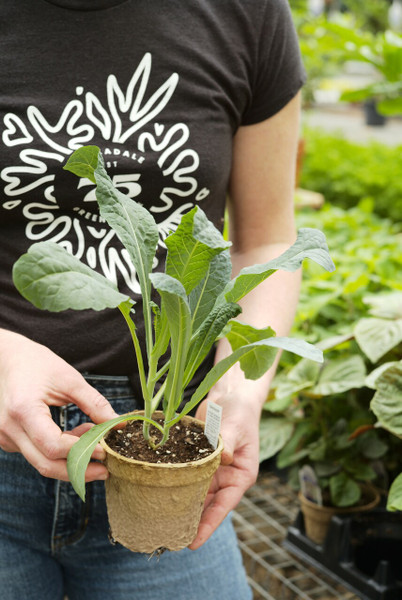Kale
Posted by Jessie Jacobson on May 24th 2022
All About Kale
Kale is an easy, quick to grow delicious and nutritious vegetable. Kale is a rich source of vitamins, minerals, and phytochemicals.
Kale belongs to the brassica family. Brassica is a genus of plants in the cabbage and mustard family. Common foods in brassica family include bok choy, broccoli, brussel sprouts, cauliflower, cabbage, kohlrabi, rutabaga, and turnips. Brassica oleracea (kale) cultivars are grown for their attractive and edible green or purple leaves.
Kale is typically grown as a cool weather annual plant, with some tolerating below freezing temperatures. Space kale plants 18-24 inches apart in full sun to part shade. Best growth will occur with 6 or more hours of direct sunlight. Plant in fertile, well-draining soil, rich organic matter or raised beds amended with Purple Cow Activated Compost. Use Tonka Terra for container plantings. Kale is fast grower requiring regular watering. Consistent watering will result in the highest quality leaves.
If growing from seed, it is recommended to start indoors 4 to 6 weeks before the average last frost date (May 15th for our area). For a fall crop, start 12 to 14 weeks before your average first fall frost date (late September). Ideal soil temperature for seed germination is 65°–85°F.
Kale is ready to harvest 30-60 days after seeds have been planted or when they have upward 10 leaves with small new leaves in the center and more mature leaves on the outside. Baby kale will be ready to be harvested 25-30 days after planting. Kale can be harvested with smaller more tender leaves or larger growth beginning with the lower outside leaves. For fastest regrowth only harvest 1/3 of the plant at a time. After first harvest, plants can produce more leaves in one or two weeks. The harvest period happens in late spring to early summer, and again in the fall. Older leaves may become discolored, these can be removed and composted. Mature plants can be harvested whole at ground level.
Check out the varieties we are growing at Tonkadale this year!
Dinosaur
Known as Nero Toscana, black Tuscan, black cabbage, black palm, and dinosaur kale. This is an heirloom variety with 3” wide green to black crinkly leaves favored by gourmets. Harvest tender young baby greens for fresh salads in 21 days when 2"–4" tall or grow full-sized plants in about 60 days.
D2M: 21-62 days
24"–48" tall, 12"–14" wide
Dwarf Blue Scotch
A classic curly dark blue-green leaf kale. Very cold hardy, compact plants sweeten after the first fall frosts. Nutritious, tender, and crunchy, it can be added to salads, stir-fries, or boiled, or steamed. This hardy variety maintains color well and is slow to bolt.
D2M: 55 days
18” tall
Redbor
Attractive ruffled tasty leaves with purple stems. Redbor is extremely cold tolerant, plants can last through hard freezes. Finely curled leaves start out blue-green and deepen to purple/magenta as temperatures drop. Curly type kale good for containers. Outer leaves can be harvested as baby greens when 2"–3" tall.
D2M: 50-60 days
12"–20" tall, 10"–18" wide
Toscano
Italian heirloom with dark blue-green leaves with a gently scalloped margin. Rich and tender with a mild kale flavor. Tolerant of both hot and cold weather. Recommended for harvesting baby leaf only. Good choice for containers.
D2M: 32 days
12"–20" tall, 10"–18" wide

